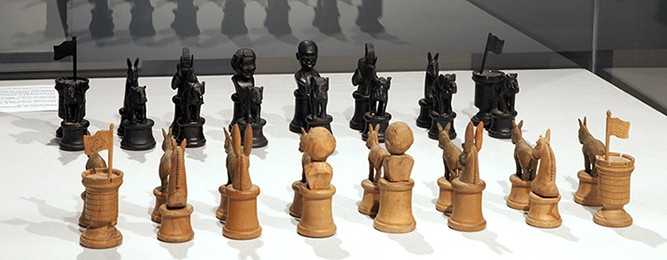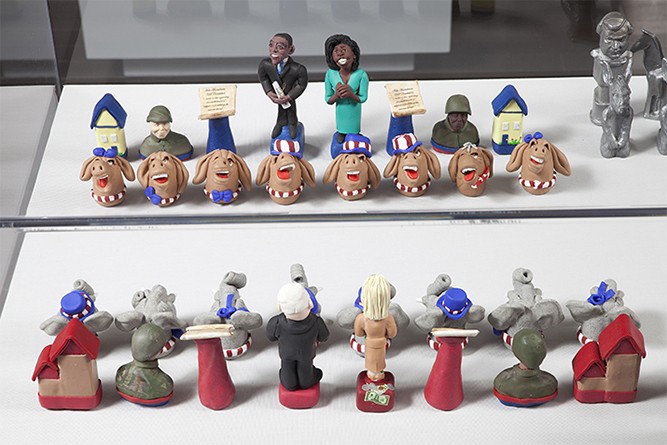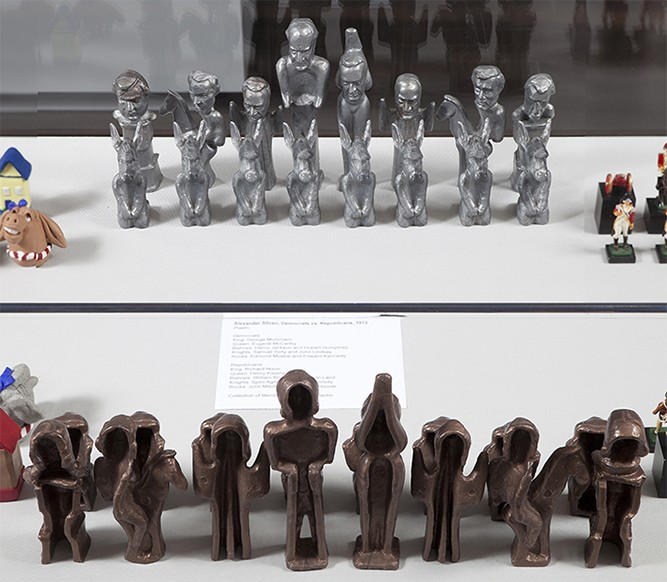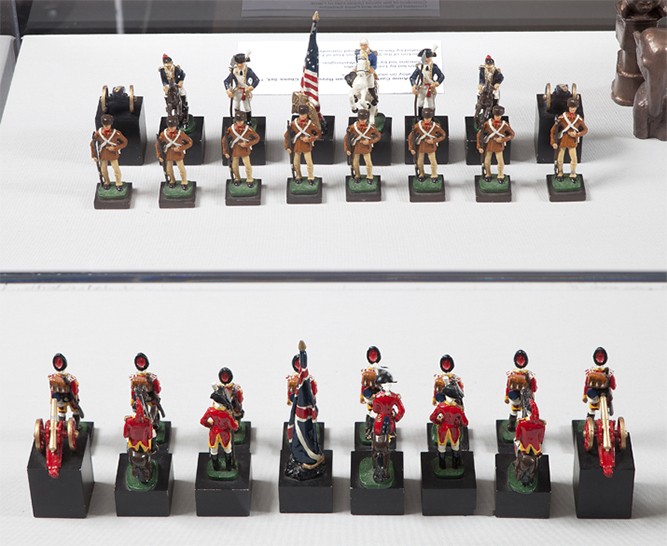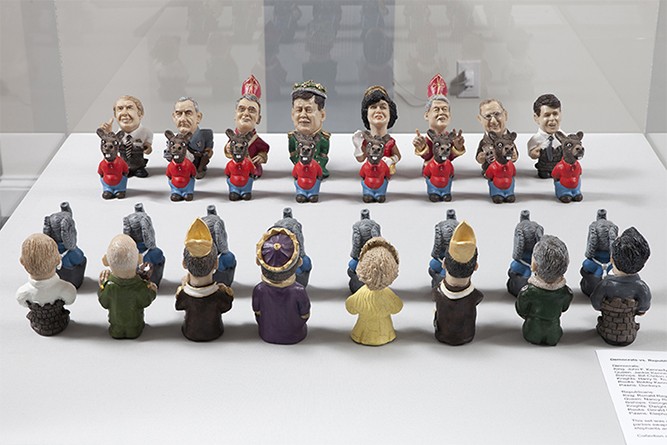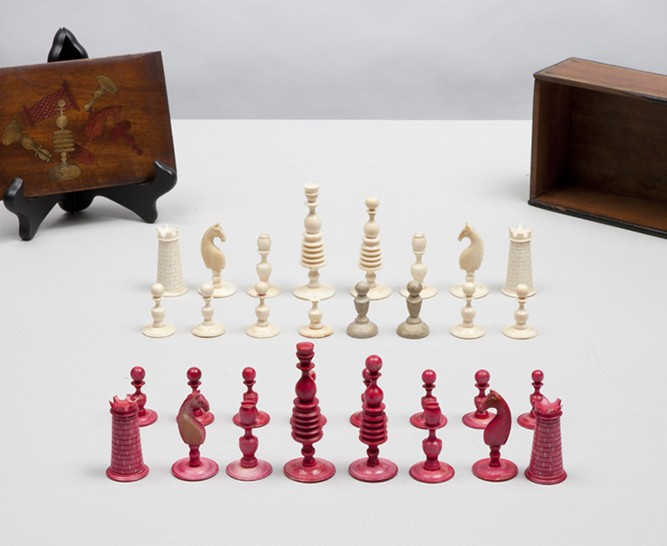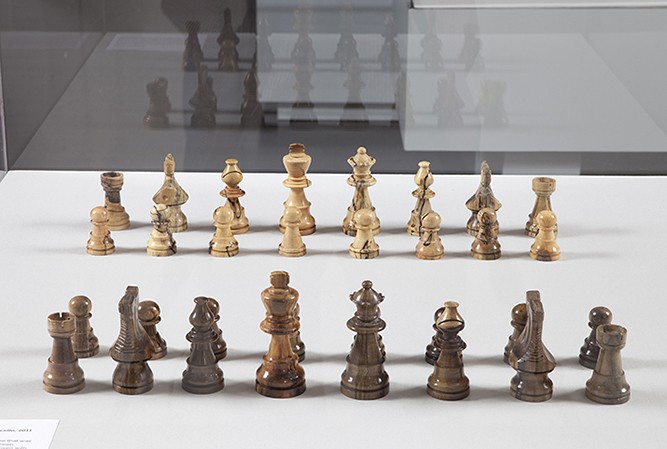Presidents of the United States
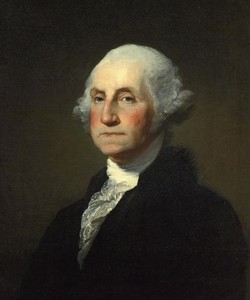
First President of the United States (No Party)
In Office April 30, 1789 – March 4, 1797
George Washington (b. 1732 – d. 1799)
Known chess player.
Chess is credited with helping Washington to win a crucial battle in the Revolutionary War. On the night of December 25–26, 1776, General Washington crossed the Delaware River with his troops on the way to Trenton, New Jersey. The Hessian regiments, camped in and around Trenton, were attacked and decisively defeated by the American Continental Army. The Hessians had supposedly let their guard down to celebrate the Christmas holiday, and British commander, Colonel Johann Gottlieb Rall (also spelled Rahl) (c. 1726 – December 26, 1776) himself was misled by John Honeyman, a spy of Washington who convincingly posed as a loyalist. According to one account, Rall was busy playing chess (though some say cards) the night before the attack at the home of Trenton merchant Abraham Hunt when he was handed a note from a local Loyalist who’d seen Washington’s forces gathering. As not to be distracted from his game, Rall placed the unread note in his coat pocket. While leading his troops in retreat from the Battle of Trenton, Rall was struck by a musket ball. He died later that day from his injuries. The note informing the general of the attack was later found in his coat pocket. The Battle of Trenton is believed to be the turning point of the Revolutionary War.
The artist and American Revolutionary War soldier John Trumbull (June 6, 1756 – November 10, 1843) was appointed second personal aide to Washington. In addition to sketching plans of the British works during the war, he drew a pen and ink sketch of General Washington and General Israel Putnam in military uniform, seated at a circular table, playing a game of chess. General Putnam (January 7, 1718 – May 29, 1790) was an American Army General and Freemason who fought with distinction at the Battle of Bunker Hill in 1775 during the American Revolutionary War.
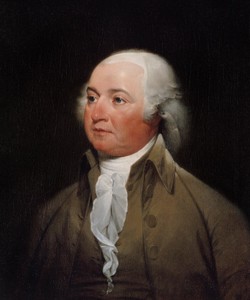
Second President of the United States (Federalist)
In Office March 4, 1797 – March 4, 1801
John Adams (b. 1735 – d. 1826)
It is not known if he played chess.
Adams was sent by Congress to France twice to represent the United States—first in 1777 and again in 1779. On his second trip, Adams was appointed Minister Plenipotentiary (a Minister/Envoy of the United States) and was charged with the mission of negotiating a treaty of amity and commerce with Britain. Adams had many problems with his missions, the first being the disapproval of the appointment by the French government and the second, his relationship with Benjamin Franklin on his excursions. In his diary of May 27, 1778, Adams wrote of his frustration and described a routine “working” day with Benjamin Franklin—a known chess enthusiast, player, and author of chess essays:
I found that the Business of our Commission would never be done, unless I did it. My two Colleagues [Franklin and Lee] would agree in nothing. The Life of Dr. Franklin was a Scene of continual dissipation. I could never obtain the favour of his Company in a Morning before Breakfast which would have been the most convenient time to read over the Letters and papers, deliberate on their contents, and decide upon the Substance of the Answers. It was late when he breakfasted, and as soon as Breakfast was over, a crowd of Carriges came to his…lodgings, with all Sorts of People; some Phylosophers, Accademicians and Economists…but by far the greater part were Women and Children, come to have the honour to see the great Franklin, and to have the pleasure of telling Stories about his Simplicity, his bald head and scattering strait hairs, among their Acquaintances… These Visitors occupied all the time, commonly, till it was time to dress to go to Dinner…and after that went sometimes to the Play, sometimes to the Philosophers but most commonly to visit those Ladies who were complaisant enough to depart from the custom of France so far as to procure Setts of Tea Geer as it is called and make Tea for him…After Tea the Evening was spent, in hearing the Ladies sing and play upon their Piano Fortes…and in various Games as Cards, Chess, Backgammon, &c. &c. Mr. Franklin I believe however never play’d at any Thing but Chess or Checquers…In these Agreable and important Occupations and Amusements, The Afternoon and Evening was spent, and he came home at all hours from Nine to twelve O’Clock at night.
May have been exposed to chess from Benjamin Franklin while in France.
May have taught his son John Quincy Adams to play.
There is conflicting information about whether he played chess. The Immortal Game, by David Shenk, mentions that he played chess, however John Adams, by David McCullough, writes that he did not know how to play.
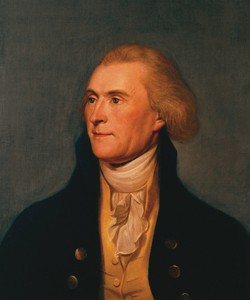
Third President of the United States (Democrat-Republican)
In Office March 4, 1801 – March 4, 1809
Thomas Jefferson (b. 1743 – d. 1826)
Known chess player.
Considered chess one of his favorite games.
Jefferson’s Memorandum Books: Accounts, with Legal Records and Miscellany, 1767-1826 note his chess-related financial transactions:
September 13, 1769 – “Send for…Chess board & men…”
March 3, 1783 – “Pd. for chess men 11 shillings 3 pence”
March 4, 1783 – “Pd…mendg. chessmen 7 shillings…”
March 7, 1783 – “Pd…mendg. chessmen 2 shillings 3 pence.”
November 12, 1783 – “…pd. Mentz for chess board 35 shillings.”
May 31, 1784 – “Pd. Rivington for maps & books L3-4 chessmen 20 shillings.”
December 6, 1784 – “Pd. Mending Chess-men 18 francs.”
February 6, 1786 – “Pd. On admission to the Salon des echecs 96 francs.”
April 1, 1786 – “Pd….for chessman 18 shillings.”
April 2, 1786 – “Pd. For repairing chessmen 10 shillings.”
April 11, 1786 – “Pd…chessmen & box 20 shillings.”
February 12, 1789 – “Pd. Roberts for chessboard $1.75”
Jefferson had an extreme hobby of collecting books. When the British burned the Library of Congress, Jefferson offered to sell his library as a replacement. Congress purchased his library—a total of 6,487 volumes—for $23,950 in 1815. Among his collection were important chess books including Analysis of the Game of Chess by François-André Danican Philidor (1726 – 1795) and books by Italian chess player and writer Gioachino Greco (c. 1600 – c. 1634) and chess master and pioneer of modern chess, Philipp Stamma (c. 1705 – 1755)
Friends and family gave him chess sets or he gave them chess sets as presents. In a letter dated October 30, 1786, Jefferson’s grandson, Francis Eppes VI (dates unknown) wrote to Jefferson, “I must now thank you for you[r] present of chess Men. They are very handsome. I shall endevour to recover what little knowledge I had of the game which for want of practice I have almost forgot.”
Both adults and children played board games at Monticello, such as The Game of the Goose, which resembles Parcheesi and was invented in Italy in the sixteenth century. Jefferson taught his granddaughter, Ellen Wayles Randolph, to play. In the summer, the two would carry the chess set outdoors and play under the trees on the West Lawn.
From the West Lawn at Monticello, Jefferson, family, and guests could walk up the stairs on the West Portico to reach the Parlor, one of three rooms in Monticello that were part of Jefferson’s original plan for the home in 1769. The Parlor was a public room, designed for conversation, music, games, and reading. The room held folding tables for games, such as a chess set that according to family tradition was a gift from the French court to Jefferson.
One set on display at Monticello is “Set of Thirty Chessmen, c. 1770-90. Dieppe, France. Ivory.” According to the family, Jefferson received this set as a gift from the French court when he was in Paris as American Minister to France from 1785-1789. A second ivory set of “Barleycorn” design, created between 1800 and 1840 had one side stained red. It is not known when or where Jefferson acquired the set but it is believed that it was created or purchased in London. The Barleycorn design was growing in popularity in the nineteenth century and was named for the leaf motif encircling the main shaft of the kings and queens, almost becoming a standard before the Staunton style emerged. These are the only two sets owned by the Thomas Jefferson Foundation. As of August 30, 2012, the Barleycorn set is on display at Monticello, while the Dieppe set was exhibited at the Smithsonian Museum of American History as part of “Slavery at Jefferson’s Monticello: Paradox of Liberty” from January 27 – October 14, 2012.
Many stories of Jefferson playing chess come from his daughter Ellen Wayles Randolph Coolidge. She wrote: “So he was, in his youth, a very good chess-player. There were not among his associates, many who could get the better of him. I have heard him speak of ‘four hour games’ with Mr. Madison. Yet I have heard him say that when, on his arrival in Paris, he was introduced into a Chess Club, he was beaten at once, and that so rapidly and signally that he gave up all competition. He felt that there was no disputing such a palm with men who passed several hours of every evening in playing chess.”
In a letter to his granddaughter Mary Jefferson Eppes dating July 31, 1791, Jefferson expressed concern for his ivory chess sets that was unaccounted for after his move to Monticello, “You mentioned formerly that the two Commodes were arrived at Monticello. Were my two sets of ivory chessmen in the drawers? They have not been found in any of the packages which came here, and Petit seems quite sure they were packed up.” Adrien Petit was Jefferson’s trusted Butler.
In his later years, he played Benjamin Franklin, also a keen player. He would write letters about Franklin and how popular he was in France because he played chess with beautiful or powerful women. In one case, Franklin was playing the Duchess of Bourbon and she moved her King into check – an illegal move. Instead of telling her the move was illegal, he captured and removed her king. Jefferson wrote, “When Dr. Franklin went to France on his revolutionary mission, his eminence as a philosopher, his venerable appearance, and the cause on which he was sent, rendered him extremely popular. For all ranks and conditions of men there, entered warmly into the American interest. He was therefore feasted and invited to all the court parties. At these he sometimes met the old Duchess of Bourbon, who being a chess player of about his force, they very generally played together. Happening once to put her king into prise, the Doctor took it. ‘Ah,’ says she, ‘we do not take kings so.’ ‘We do in America,’ says the Doctor.”
His Vice President was Aaron Burr, another enthusiastic and strong chess player.
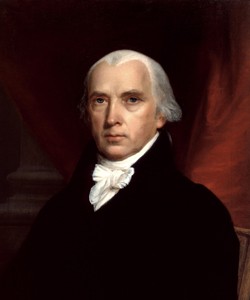
Fourth President of the United States (Democrat-Republican)
In Office March 4, 1809 – March 4, 1817
James Madison (b. 1751 – d. 1836)
Known chess player.
He was an avid chess player and often played with Thomas Jefferson and John Quincy Adams. According to stories of Jefferson’s granddaughter, Ellen Wayles Coolidge, his battles against Jefferson were “epic” and they lasted for hours. According to Coolidge, Jefferson “was, in his youth, a very good chess-player. There were not…many who could get the better of him. I have heard him speak of ‘four hour games’ with Mr. Madison.”
Madison’s love of chess was such that he was even known to play on Sundays, something that was just not done in his day. Gaming was not acceptable to do on Sundays. According to researchers at Montpelier, that implies that Madison viewed chess as not a game but as an intellectual pursuit.
James Roberts, author of James Madison, discusses the lives of the Madisons in Washington D.C. and writes, “The Madisons lived in a large house on F Street. They often hosted parties there. After dinner, guests might enjoy a game of backgammon as well as conversation. Madison was also fond of chess. He studied moves very carefully, considering each step before proceeding. His habit often carried over into his dealings as Secretary of State. He tended to consider his actions very carefully, covering every possible outcome before deciding to proceed.”
In James Madison: Builder: A New Estimate of A Memorable Career, Abbot Emerson Smith wrote, “Madison was no grim recluse. He was noted for witty conversation, for the number of his anecdotes, and like Jefferson, for his skill at chess.” He also wrote, “Fond as he was of dinners and parties, the diminutive Madison did not like to dance. When Robert Smith, the wealthy Secretary of the Navy gave a great ball, Madison attended but spent the evening playing chess with John Quincy Adams.”
In February 2011, archaeologists unearthed pieces of two ivory pawns from Madison’s personal set. The pieces were discovered during an excavation of a trash pit at his estate in Virginia, Montpelier. It is believed that these pieces are likely the same set that Madison and Thomas Jefferson used in their frequent matches, which was given to Madison by Benjamin Franklin. A full period set has been purchased that is believed to be an exact match to Madison’s original. It is now displayed at Montpelier atop one of his original gaming tables. The hand-turned pieces are in the Old English or Washington style—which gets its name because George Washington owned a set of that style. The pieces are red and white. The Old English style was a very fashionable and popular style of that time period.
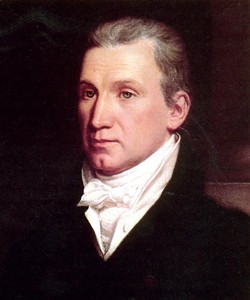
Fifth President of the United States (Democrat-Republican)
In Office March 4, 1817 – March 4, 1825
James Monroe (b. 1758 – d. 1831)
Known chess player.
Bought several chess books from Jefferson, including François-André Danican Philidor’s Analysis of the Game of Chess, when Jefferson departed for France according to James Monroe, The Quest for National Identity, by Harry Ammon.
Played chess against Thomas Jefferson and Aaron Burr.
Also played checkers, poker, whist, and dominoes according to The Last Founding Father: James Monroe and a Nation’s Call to Greatness, by Harlow Giles Unger.
One of his sets is in the collection of the James Monroe Museum in Virginia. According to the museum, this set, half of which is dyed red, belonged to Monroe while he was Governor of Virginia. Monroe family tradition suggests that Monroe’s playing set was given to the Governor by his mentor and friend, Thomas Jefferson. Robert R. Radcliff, in his 1974 article entitled “Historic Chessman,” stated that “Monroe’s chess set was made of bone and of French or English origin.” The set dates c. 1790-1810, and is strikingly similar to one owned by the George Vanderbilt family at Biltmore (which was made for the China export trade).
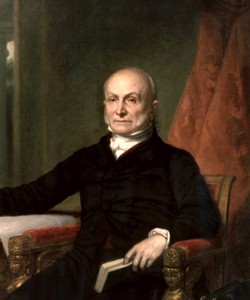
Sixth President of the United States (Democrat-Republican)
In Office March 4, 1825 – March 4, 1829
John Quincy Adams (b. 1767 – d. 1848)
Known chess player.
May have learned chess from his father, John Adams, or Benjamin Franklin, whom he stayed with while in France.
In James Madison, James Monroe, and John Quincy Adams, William Osborn Stoddard wrote, “He (Adams) sailed from England on June 17th, 1817, and it was almost a matter of course that his voyage should be tedious. It lasted seven weeks, and he landed in New York August 7th, declaring that the game of chess surpassed all other resources for killing time at sea.”
The Presidential Election of 1828 was filled with mudslinging between the supporters of Adams and Andrew Jackson. Adams was accused of using public funds to purchase gambling devices for the White House. He, in fact, did purchase an ivory chess set and billiards table; however, he used his own money. Adams lost the election.
The Chicago Tribune, in a 2004 article “A dozen visual gems you probably won’t find listed in a travel guide” noted that one should view the details atop entrances and exits to the Quincy “L” stop at Wells and Quincy Streets. “Decorative chess pawns were a part of the original station structure, at the base of slanted roofs covering the staircases, in the late 19th Century. They disappeared before the 1950s but were replaced during a restoration at the end of the ‘80s. President John Quincy Adams was a chess player who collected chess sets.”
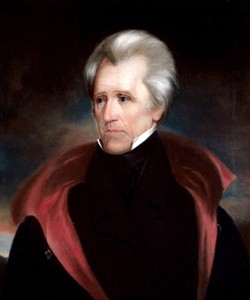
Seventh President of the United States (Democrat)
In Office March 4, 1829 – March 4, 1837
Andrew Jackson (b. 1767 – d. 1845)
Known chess player.
In The American Lion: Andrew Jackson in the White House, author John Meacham described Jackson as an excellent chess player.
The diary of Julia Ann Conner, a young woman from South Carolina, described a visit to the home of General Jackson and his wife Rachel beginning on September 3, 1827—a year before his election. One evening Conner was playing chess with another houseguest and wrote that Jackson, “stood at my side, and being an excellent player he frequently directed my moves—apparently much interested in the fate of the game…there were no traces of the ‘military chieftain’ as he is called!” From The American Lion: Andrew Jackson in the White House.
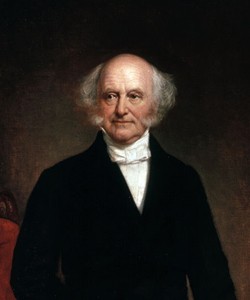
Eighth President of the United States (Democrat)
In Office March 4, 1837 – March 4, 1841
Martin van Buren (b. 1782 – d. 1862)
It is not known if he played chess.
Martin’s son, John Van Buren (1810-1866) was chosen by the New York Chess Club’s Testimonial Committee to present Paul Morphy with the silver and gold chessmen and pearl inlaid board on the American champion’s triumphal return from Europe, celebrated on May 25 1859, at the chapel of New York University. Chess Monthly: An American Chess Serial, Volume 3, by Willard Fiske and Paul Charles Morphy (1859) describes the presentation:
The hall of the University of the city of New York was densely crowded with an intelligent and distinguished audience, on the evening of Wednesday, May 25th, to witness the formal presentation to Mr. Morphy of the testimonials of esteem from the citizens of the commercial metropolis. Among the audience were all the noted men of science and letters in the city. After some introductory remarks by Colonel Charles D. Mead, President of the New York City Chess Club, the Honorable John Van Buren proceeded to present the superb set of gold and silver men and the magnificent board manufactured by Tiffany & Co., and which form a chess equipage fit for the sovereign of the game. Mr. Van Buren gave a rapid account of the royal sport, interspersed with a multitude of interesting anecdotes, and closed with some eloquent remarks on Mr. Morphy’s tour in Europe.
A transcript of Van Buren’s speech reads:
Mr. Morphy: A number of your friends and admirers have deemed it appropriate to signalize your return to the United States by this reception, and by the presentation to you of a testimonial of their admiration and regards. I am happy to be enrolled among their number, and feel honored at having been selected to convey to you their sentiments, and to offer for your acceptance this beautiful specimen of taste and skill to those to whom its execution was confided…For more than a thousand years [chess] has been played in Europe. “Like a universal alphabet’ as a clever writer has said ‘the chessboard is known to all nations…” Ladies and gentlemen, I ask you to unite with me in welcoming with all honors, Paul Morphy, the Chess Champion of the World.
Despite his role in welcoming Morphy back to the United States, it is written in John Van Buren: Politician: A Novel of To-day, published by Harper & Brothers in 1905, “He could not understand why men wasted time and thought on chess and whist, both of which he tried when the greatest game in the world, politics, was open to all.”
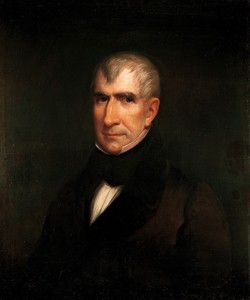
Ninth President of the United States (Whig)
In Office March 4, 1841 – April 4, 1841
William Henry Harrison (b. 1773 – d. 1841)
It is unknown if he played chess.
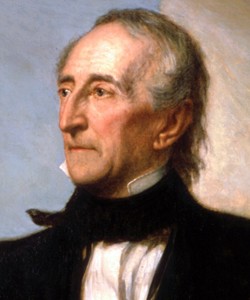
Tenth President of the United States (Whig)
In Office April 4, 1841 – March 4, 1845
John Tyler (b. 1790 – d. 1862)
It is unknown if he played chess.
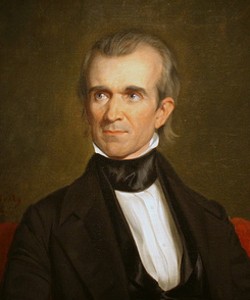
Eleventh President of the United States (Democrat)
In Office March 4, 1845 – March 4, 1849
James Polk (b. 1795 – d. 1849)
It is unknown if he played chess.
In one of his correspondence letters dated May 9, 1844 to Samuel Laughlin discussing his own nomination for Presidency by the Democratic National Convention, Polk writes, “From what Cave Johnson writes, I think the recent occurrances (sic) on the chess-board, have decidedly improved my prospects.” From Correspondence of James K. Polk, January –August 1844 by James K. Polk. Cave Johnson (1793-1866) was a Democratic Congressman from Tennessee. He went on to be the Postmaster General under Polk.
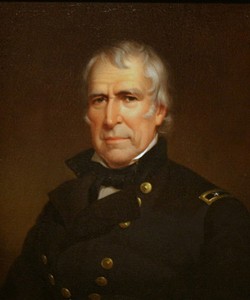
Twelfth President of the United States (Whig)
In Office March 4, 1849 – July 9, 1850
Zachary Taylor (b. 1784 – d. 1850)
It is unknown if he played chess.
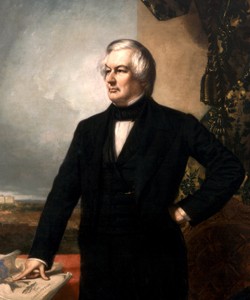
Thirteenth President of the United States (Whig)
In Office July 9, 1850 – March 4, 1853
Millard Fillmore (b. 1800 – d. 1874)
Played chess but did not encourage the game.
According to Fillmore biographer Robert Scarry, in 1842, Fillmore’s son, Millard, wrote to his father about the game of chess, “It is pleasant after having studied for sometime [sic] it rests anyone for it brings difficult faculties from what you use in committing to memory and about all my studies are of that kind.” Fillmore did not want his son to waste time playing chess and wrote back to him, “It is too sedentary; and I fear so much sitting will make you crooked…learn to pitch quoits. That is a very active and gentlemanly game.”
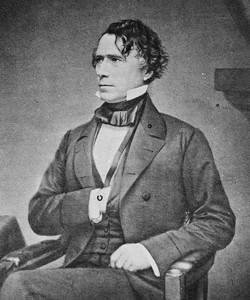
Fourteenth President of the United States (Democrat)
In Office March 4, 1853 – March 4, 1857
Franklin Pierce (b. 1804 – d. 1869)
It is unknown if he played chess.
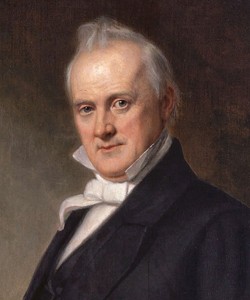
Fifteenth President of the United States (Democrat)
In Office March 4, 1857 – March 4, 1861
James Buchanan (b. 1791 – d. 1868)
It is unknown if he played chess.
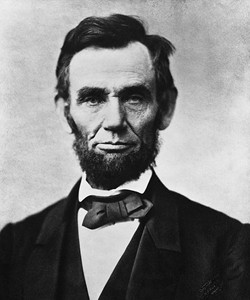
Sixteenth President of the United States (Republican)
In Office March 4, 1861 – April 15, 1865
Abraham Lincoln (b. 1809 – d. 1865)
Known chess player.
Was thought to be a very good chess player.
An excerpt from an article in The New York Times from November 15, 1860 discusses traits of the next President who had been elected on November 6, 1860: “THE NEXT PRESIDENT.; LETTERS FROM MR. LINCOLN’S HOME. What his Neighbors Think of his Election—A Personal Interview—A Characteristic Visitor—Col. Ellsworth in a New Character, &c.”:
Speaking of custom, reminds me of a curious custom of Mr. LINCOLN while playing chess—for be it known to the disciples of CAISSA, the devotees of MORPHY, PAULSEN, ANDERSON, STAUNTON, LlCHTENHElN, and the army of chess-players, that Mr. LINCOLN takes delight in the movements on the ordinary, as well as of the political chess-board, and plays a very fair game, but not a first-rate one. He has a habit of whistling and singing all the time—his musical ability being confined to one tune, and that tune, I sagely suspect, is “Dixie’s Land.” While playing chess, Mr. LINCOLN seems to be continually thinking of something else. Those who have played with him say he plays as if it were but a mechanical pastime to occupy his hands while his mind is busy with some other subject, just as one often twirls a cane, or plays with a string, or as a pretty coquette toys with her fan. The way any man plays, either at a game of skill or of chance, is generally a pretty fair index to his character. Success or defeat—the chances—the variations in the probability of triumph—the turning point in the struggle—the exhibition of temper under all circumstances—the stubborn defence in hopeless resistance—the spirited attack with the weaker force, and all the incidents of mimic warfare con tribute to develop the strong points of a man’s disposition. Nor does Mr. LINCOLN suffer by judgment under this rule. He plays what chess-players call a “safe game.” Rarely attacking, he is content to let his opponent attack while he concentrates all his energies in the defence—awaiting the opportunity of dashing in at a weak point, or the expenditure of his adversary’s strength, self-reliant in adversity, magnanimous in success, and undaunted by defeat, he is the model of a chess general. His abstractedness, however, must not be regarded as applicable to ordinary pursuits. He seizes a point in conversation with remarkable quickness—often anticipating the meaning before the sentence is concluded.
A few years before Lincoln became President, he played chess with Judge Samuel H. Treat (1811-1887), Chief Justice of the Illinois Supreme Court. Accoriding to Treat, whom Lincoln biographer Jesse W. Weik interviewed in 1883:
One morning Lincoln came to his office and joined him in a game of chess. The two were enthusiastic chess-players and when the opportunity offered indulged in the game. On the occasion named they were soon deeply absorbed, nor did they realize how near it was to the noon hour until one of Lincoln’s boys came running in with a message from his mother announcing dinner at the Lincoln home, a few steps away. Lincoln promised to come at once and the boy left; but the game was not entirely out; yet so near the end the players, confident that they would finish in a few moments, lingered a while. Meanwhile almost half an hour had passed. Presently the boy returned with a second and more urgent call for dinner; but so deeply engrossed in the game were the two players they apparently failed to notice his arrival. This was more than the little fellow could stand; so that, angered at their inattention, he moved nearer, lifted his foot, and deliberately kicked board, chessmen, and all into the air. “It was one of the most abrupt, if not brazen, things I ever saw,” said Treat, “but the surprising thing was its effect on Lincoln. Instead of the animated scene between an irate father and an impudent youth which I expected, Mr. Lincoln without a word of reproof calmly arose, took the boy by the hand, and started for dinner. Reaching the door he turned, smiled good-naturedly, and exclaimed, ‘Well, Judge, I reckon we’ll have to finish this game some other time,’ and passed out. Of course I refrained from any comment,” continued Treat, who, by the way, was old and had never been blessed with a child,” but I can assure you of one thing: if that little rascal had been a boy of mine he never would have applied his boots to another chessboard.” From The Real Lincoln, by Jesse W. Weik, p. 102-103.
According to The Lincoln Institute, Mr. Lincoln enjoyed and excelled at both physical and mental games. Mr. Lincoln was a participant in the debating club organized in New Salem in 1832, and he was one of the founders of the Young Men’s Lyceum in Springfield. George Washington Harris, a clerk in Lincoln’s law office in Springfield recalled: “Mr. Lincoln was fond of playing chess and checkers, and usually acted cautiously upon the defensive until the game had reached a stage where aggressive movements were clearly justified. He was also somewhat fond of ten-pins, and occasionally indulged in a game.” From The Every-day Life of Abraham Lincoln, by Francis Fischer Browne.
George Harrison, a friend of Lincoln, wrote of their time in the militia during the Black Hawk War, “We passed our evenings by jumping, playing checkers, chess, swimming our horses.” From Lincoln: The Biography of a Writer, by Fred Kaplan.
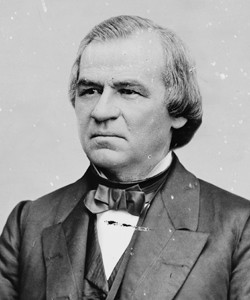
Seventeenth President of the United States (Democrat)
In Office April 15, 1865 – March 4, 1869
Andrew Johnson (b. 1808 – d. 1875)
There is no evidence that he played chess.
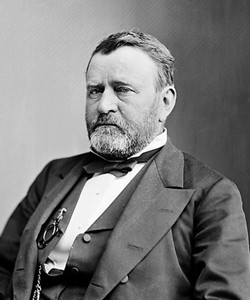
Eighteenth President of the United States (Republican)
In Office March 4, 1869 – March 4, 1877
Ulysses S. Grant (b. 1822 – d. 1885)
Known chess player.
In A Personal History of Ulysses S. Grant, author Albert Deane Richardson paints a picture of a simple Grant before he became the great General and later President of the United States. “He had shown little interest in politics, and had never voted but once. Though a very close reader of newspapers, he lacked the culture derived from books. In hours of leisure he wooed not history, philosophy, nor poetry—but euchre, whist, and chess; smoking his clay pipe, and between the games, relating incidents of the Mexican war and of garrison life in Oregon.”
William Crafts, in Life of Ulysses S. Grant: His Boyhood Campaignes, and Services, Military, and Civil, wrote of Grant, “His characteristic persistency was illustrated at West Point not only by his application to studies, but by his playing the game of chess, of which he was fond. When he found a player who was at first more than a match for him, he persisted in playing till he ‘tired out’ his antagonist, and at last beat him.”
Grant’s Vice President, Henry Wilson, toasted Paul Morphy on June 1, 1859 when Wilson was a Massachusetts Senator. His toast read:
“Our national representatives—their position gives them a special interest in national success,” he most fittingly replied, “I suppose we all feel proud of the achievements of our American representatives in the Old World. We all unite to do honor to him who has achieved honor for the American nation abroad. As we have read of his brilliant achievements with pride and admiration, we have loved him because he has been throughout a modest and quiet American gentleman. Surrounded as Mr. Morphy has been by royalty, learning, and genius, in all his splendid triumphs he has borne himself with modesty, and he ought to be welcomed by every American. We have witnessed here to-night his modest demeanor and noble carriage with pleasure.” ... [In conclusion, he gave this sentiment:] “The modest bearing of your guest—worthy the imitation of American scholars, artists, jurists, and statesmen, who uphold the intellectual character of America among the nations.”
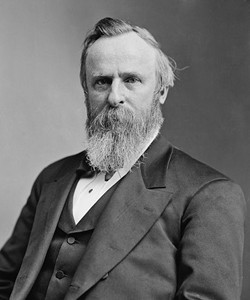
Nineteenth President of the United States (Republican)
In Office March 4, 1877 – March 4, 1881
Rutherford B. Hayes (b. 1822 – d. 1893)
Known chess player.
His mother taught him and his sister, Fanny, how to play chess. Hayes mentioned in his diary that Fanny was a skillful player.
Hayes wrote of chess in his diaries and letters:
To his sister, Fanny, May 13, 1839 – I do not doubt that H. P.—can beat me at chess. I have played but once since I wrote to you before. Playing ball is all the fashion here now and it is presumed that I can beat you at that if not at chess.
To his sister, Fanny, STEAMER MORO CASTLE, MISSISSIPPI RIVER—NEAR CAIRO, December 16, P. M., [1848] – (Describing his time spent on a boat) …a gentleman who plays chess just well enough to make it hard work for me to beat him, which I do twice out of three times…
Wednesday, January 3 – Fine weather. Spent at home, writing letters, pistol firing, and playing chess.
Tuesday, January 2, 1849 – Start on a visit to the Misses Lewis, but learn that they are absent from home. Weather fine. Return and afternoon take a ramble with Henry after deer. Saw seven, also a wild hog. Had two shots at too great a distance to do hurt. Saw “Gus” “rope” (lasso) a wild cow. Exciting and somewhat perilous, in the eyes of the uninitiated. Home at dark and had chess with Henry until a late hour.
December 23, 1846 – The old year is waning, the new drawing on. My partner has gone to Columbus and several days past I have spent alone. There is but little office business at this season of the year and the days and long winter evenings pass off slowly, almost too slowly. I read some law, some poetry (Shakespeare), and play chess occasionally. Somehow my faculties are so dull that nothing but chess seems to excite the attention enough to arouse them [at] all. It surprises me when I think of it. What a world of time and brains are wasted in idle daydreams, castle-building, visions of happiness too rapturous for reality. Am I in love, that it grows on me, or is it habit rioting unchecked?
From his boyhood – When very young she was taught to ride, play chess, and shoot with a rifle. Although she was always a retiring, quiet, modest little girl, even so as to be a favorite with those whose sense of propriety swallows up every other virtue, yet in many manly sports she was perfectly fearless and very successful. She rode gracefully and was the best rifle-shot of any lady I ever knew. She was a skillful player at chess and indeed of many other games.
To his uncle, May 22, 1850 – Remember me to Mr. Lincoln. I should like to see him here. I could show him some of the prettiest girls above ground. Is not that inducement enough to bring him here? Tell Pease that one of the Hungarian refugees who was here could beat Dr. Schmidt and the best chess players here, and throw off a castle. It satisfied me that I never had seen any one who knew the alphabet of the game before.
To his mother, January 27, 1849 – (writing about his trip to Gulf Prairie, Texas) Guy, Eliza, and myself visit the young ladies when it is pleasant weather, and read, play chess and games when it rains.
To his uncle, November 29, 1861 – I wish you were in health. It would be jolly for you to come up and play chess with the colonel and see things. As soon as we are in order, say four or five weeks, I can come home as well as not and stay a short time.
In William Howells’ Sketch of the Life and Character of Rutherford B. Hayes, an old college friend reminisces about Hayes, “Hayes was the champion in college, in debate class section, and in the foot-path; cheerful, sanguine, and confident of the future, never seeing cause for desponding; was a young man of substantial physique; in my whole acquaintance, I never knew of his being sick one day, and so free from any weakness as to seem indefatigable. His greatest amusements were fishing and chess.”
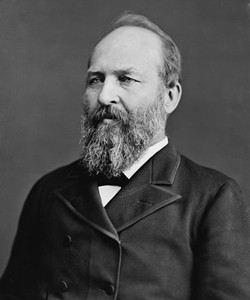
Twentieth President of the United States (Republican)
In Office March 4, 1881 – September 19, 1881
James A. Garfield (b. 1831 – d. 1881)
Known chess player.
He played chess with Salmon P. Chase (1808-1873), who was an Ohio Senator and Governor, U.S. Treasury Secretary, and Chief Justice of the United States according to John Waugh in Reelecting Lincoln: The Battle for The 1864 Presidency. Chase was described as Garfield’s “Chess partner.” He goes on to write, “Chase was also fond of the young Ohio general James A. Garfield, whom he treated rather like the son he never had. Garfield lived with the Chases for a time in the fall of 1862, and the two men played chess in the evenings and discussed the conduct of the war together over the bishops and kings.” The war that is being referred to is the Civil War.
In The Life and Work of James A. Garfield, John Clark Ridpath wrote about Garfield’s time at Williams College. “He was there for work, not play. At one time he caught the fever for playing chess. He was a superior player, and enjoyed the game immensely. But when he found it carried him to late hours, he denied himself the pleasure entirely.”
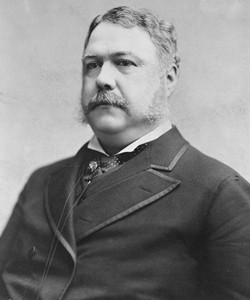
Twenty-first President of the United States (Republican)
In Office September 19, 1881 – March 4, 1885
Chester A. Arthur (b. 1829 – d. 1886)
There is no evidence that he played chess.
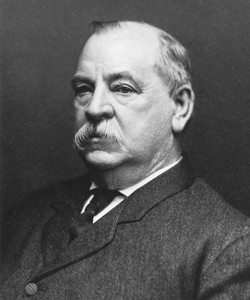
Twenty-second President of the United States (Democrat)
In Office March 4, 1885 – March 4, 1889
Grover Cleveland (b. 1837 – d. 1908)
Known chess player.
Cleveland and his Vice President visited the Eden Museé in New York City to see Ajeeb the chess automaton. The trip was described in the September 1885 issue of The International Chess Magazine: “Ajeeb, ‘The Chess Automaton’, is now giving exhibitions at Eden Musee, Twenty-third Street, New York. We learn from the Evening Telegram that President Cleveland and Vice-President Hendricks paid a visit recently to Ajeeb’s chess room, and the latter had a game with the figure which ‘The Automaton’ finished with a neat five-move version of the so-called Philidor’s Legacy or smothered mate.” It is not known who was inside the automaton that night. A brochure from Eden Museé described Ajeeb:
AJEEB, THE CHESS PLAYER: Visitors while on the gallery should not fail to see AJEEB, the mysterious chess and checker playing automaton. It represents a Moorish figure seated on a cushion, beneath which is a perfectly open table; in front is a small cabinet with doors, which are all open, as well as the back and chest of the figure. Any stranger is at liberty to play a game with the automaton; the movements of the figure are free and easy, and it shifts the pieces with as much accuracy as its living opponents and with much greater success, generally coming off the conqueror. In giving check to the king the automaton makes a sign by raising his head twice, and for checkmate three times.
The British Chess Magazine from January, 1893, wrote of Grover Cleveland’s involvement with the Columbian Chess Congress:
The following circular has been issued by the committee of the Columbian Chess Congress: New York, May 20th, 1893. At a meeting of the representative members of the Manhattan Chess Club, the Brooklyn Chess Club, the City Chess Club of New York, and the Staten Island Chess Congress in this City February 11th, 1893, the preliminary steps were taken to hold a Chess Congress in this city in connection with the Columbian Festivities. Grover Cleveland, President of the United States, has consented to become a patron of the Congress to present to the winner of the tournament a GOLD MEDAL… Yours very respectfully, Frederick J. Janusch, Hon. Sec., 215, East 44th Street, N.Y.C.
Unfortunately, while the Columbian Celebration took place in New York—a celebration of the 400th anniversary of Columbus’ voyage to the Americas—the Columbian Chess Congress was canceled due to financial difficulties.
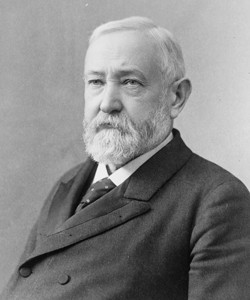
Twenty-third President of the United States (Republican)
In Office March 4, 1889 – March 4, 1893
Benjamin Harrison (b. 1833 – d. 1901)
There is no evidence that he played chess.

Twenty-fourth President of the United States (Democrat)
In Office March 4, 1893 – March 4, 1897
Grover Cleveland (b. 1837 – d. 1908)
Known chess player.
Cleveland and his Vice President visited the Eden Museé in New York City to see Ajeeb the chess automaton. The trip was described in the September 1885 issue of The International Chess Magazine: “Ajeeb, ‘The Chess Automaton’, is now giving exhibitions at Eden Musee, Twenty-third Street, New York. We learn from the Evening Telegram that President Cleveland and Vice-President Hendricks paid a visit recently to Ajeeb’s chess room, and the latter had a game with the figure which ‘The Automaton’ finished with a neat five-move version of the so-called Philidor’s Legacy or smothered mate.” It is not known who was inside the automaton that night. A brochure from Eden Museé described Ajeeb:
AJEEB, THE CHESS PLAYER: Visitors while on the gallery should not fail to see AJEEB, the mysterious chess and checker playing automaton. It represents a Moorish figure seated on a cushion, beneath which is a perfectly open table; in front is a small cabinet with doors, which are all open, as well as the back and chest of the figure. Any stranger is at liberty to play a game with the automaton; the movements of the figure are free and easy, and it shifts the pieces with as much accuracy as its living opponents and with much greater success, generally coming off the conqueror. In giving check to the king the automaton makes a sign by raising his head twice, and for checkmate three times.
The British Chess Magazine from January, 1893, wrote of Grover Cleveland’s involvement with the Columbian Chess Congress:
The following circular has been issued by the committee of the Columbian Chess Congress: New York, May 20th, 1893. At a meeting of the representative members of the Manhattan Chess Club, the Brooklyn Chess Club, the City Chess Club of New York, and the Staten Island Chess Congress in this City February 11th, 1893, the preliminary steps were taken to hold a Chess Congress in this city in connection with the Columbian Festivities. Grover Cleveland, President of the United States, has consented to become a patron of the Congress to present to the winner of the tournament a GOLD MEDAL… Yours very respectfully, Frederick J. Janusch, Hon. Sec., 215, East 44th Street, N.Y.C.
Unfortunately, while the Columbian Celebration took place in New York—a celebration of the 400th anniversary of Columbus’ voyage to the Americas—the Columbian Chess Congress was canceled due to financial difficulties.
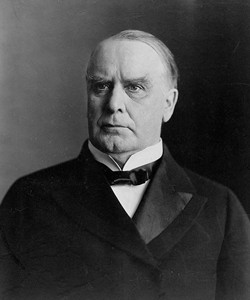
Twenty-fifth President of the United States (Republican)
In Office March 4, 1897 – September 14, 1901
William McKinley (b. 1843 – d. 1901)
There is no evidence that he played chess.
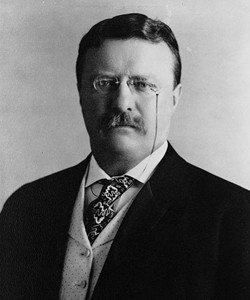
Twenty-sixth President of the United States (Republican)
In Office September 14, 1901 – March 4, 1909
Theodore Roosevelt (b. 1858 – d. 1919)
Known chess player.
Roosevelt wrote of his trip to Europe when he was 10 years old in his diary. While in London, the Roosevelts visited The Crystal Palace, a large cast-iron and plate-glass building created for the Great Exhibition of 1851. There Roosevelt saw Ajeeb, a chess automaton, which was actually a gentleman inside of a machine meant to fool the human player. “July 7th, We went to the christal palace which is very wonderful. It has imitations of Egyptian, roman, greek, etc. marbles. There was some stuffed animals and live ones and a figure that played chess and then came home and saw a (from the hotel window) a monkey who got on a ponie and perfor[m]ed severel feats with a gun and sword.” From Theodore Roosevelt’s Diaries of Boyhood and Youth.
In 1899, the Universities Cable Match took place between American and British Universities. The U.S. team lost by 1 game. During his New York governorship, Roosevelt cabled the following message to London: “Executive Mansion, Albany, April 21, 1899. International University Teams, Knickerbocker Athletic club, New York: Gentlemen: As a graduate of one of the universities represented and a warm admirer of all of them, I heartily congratulate the members of the English and American university teams on their first international contest. Chess is, of course, the game of all games, in point of skill, of patience, of strategy and mental darling. May the best team win. Yours very cordially, Theodore Roosevelt.” New York Times, April 22, 1899 & American Chess Magazine, Vol. 2, No. 11, May 1899.
Roosevelt wrote of his ranch-house and activities done there in Hunting Trips of a Ranchman and The Wilderness Hunter, “In summer time we are not much within doors, for we rise before dawn and work hard enough to be willing to go to bed soon after nightfall. The long winter evenings are spent sitting round the hearthstone, while the pine logs roar and crackle, and the men play checkers or chess, in the fire light.”
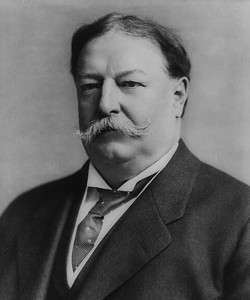
Twenty-seventh President of the United States (Republican)
In Office March 4, 1909 – March 4, 1913
William Howard Taft (b. 1857 – d. 1930)
Known chess player.
According to the National Park Service Website for the William Howard Taft Historical Site, Taft played chess as a child. It states, “quiet evenings were spent in the library. Alphonso (William’s father) finished up the day’s business, Louise (William’s mother) sometimes had sewing to do, and the children read or brooded over the chess table.”
Taft’s son, Robert, was a chess player and according to Taft’s daughter, Helen, “When Bob was eight he was a good checker player and decided he wanted to learn chess. He got a book and taught himself and so, I could never win from him.” From The Political Speaking of Senator Robert A. Taft, 1939 to 1953.
In a story about presidential candidate Taft, a story in LIFE from February 9, 1948 writes, “Robert Alphonso, born Sept. 8, 1889, in Cincinnati grew up as the solemn one in a gay household; he was always trying to interest someone in a game of chess.”
Doug Wead in All the President’s Children wrote of Robert’s chess skills, “On April 17, 1900, the Taft gamily boarded the army transport Hancock, bound for the Philippines. President McKinley had just appointed William Howard Taft, Sr., as the civil governor of the island nation. Eleven years old at the time, Robert had taught himself to play chess from a book. He promptly beat all the army officers on board.” Robert went on to be a Republican Senator and presidential hopeful.
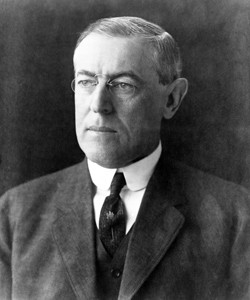
Twenty-eighth President of the United States (Democrat)
In Office March 4, 1913 – March 4, 1921
Woodrow Wilson (b. 1856 – d. 1924)
Known chess player.
Carol Dommermuth-Costa, author of Woodrow Wilson, wrote that Wilson and his father shared many hours playing chess and billiards.
In 1898, Wilson played a chess game against Salomon Langleben in Buffalo, New York. At the time, Dr. Wilson was a Princeton University professor and Langleben was the champion of Buffalo. Wilson lost in 45 moves. The game was printed in Chess Life, January 5, 1953, p. 6.
Game Notation:
1. Nf3 d5
2. d4 Bf5
3. e3 Nf6
4. c4 e6
5. Nc3 Nc6
6. a3 a6
7. b4 dxc4
8. Bxc4 b5
9. Be2 Bd6
10. Nh4 Bg6
11. Bf3 Qd7
12. e4 e5
13. d5 Nd4
14. Nxg6 Nxf3+
15. Qxf3 fxg6
|
16. Bb2 O-O
17. O-O Nxd5
18. Qg3 Nf4
19. Rad1 Qe7
20. Rd2 c6
21. Rfd1 Rad8
22. f3 Bc7
23. Qf2 Qg5
24. Kh1 Rxd2
25. Rxd2 Rb8
26. Rd7 Bb6
27. Qd2 Be3
28. Qc2 Nh3
29. Nd1 Bb6
30. Qxc6 Nf4
|
31. Qc2 h6
32. Bc1 Qh4
33. Qd2 Rc8
34. Ne3 Bxe3
35. Qxe3 Rc2
36. Bd2 Rb2
37. g3 Rb1+
38. Bc1 Qh3
39. Rxg7+ Kxg7
40. Qa7+ Kf6
41. Qb6+ Ne6
42. Qg1 Rb3
43. Qd1 Nd4
44. f4 Rxg3
45. fxe5+ Kxe5 [0-1]
|
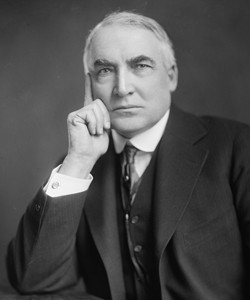
Twenty-ninth President of the United States (Republican)
In Office March 4, 1921 – August 2, 1923
Warren G. Harding (b. 1865 – d. 1923)
Known chess player.
Harding played chess through the mail with William T. Kerr, founder of the American Flag Day Association of Western Pennsylvania and thought to be one of the founders of Flag Day.
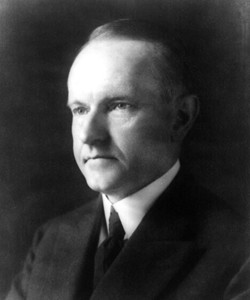
Thirtieth President of the United States (Republican)
In Office August 2, 1923 – March 4, 1929
Calvin Coolidge (b. 1872 – d. 1933)
Known chess player.
In the book, The Tormented President: Calvin Coolidge, Death, and Clinical Depression, author Robert E. Gilbert argues that Coolidge was not the somber boy that never enjoyed himself or had a good time as was once believed. He writes of fun activities young Coolidge recorded in his diary, including one entry on February 25, 1886, “Played chess with Dal and beat him every game.”
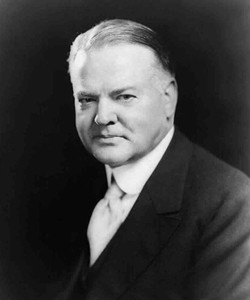
Thirty-first President of the United States (Republican)
In Office March 4, 1929 – March 4, 1933
Herbert Hoover (b. 1874 – d. 1964)
Known chess player.
Played chess as a boy.
David Burner writes in Herbert Hoover: A Public Life: He was remembered by a contemporary who kept up with him over the years as “a very quiet, introspective nontalkative lad who played a little chess and a little checkers.”
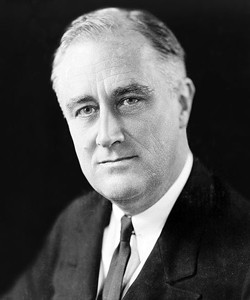
Thirty-second President of the United States (Democrat)
In Office March 4, 1933 – April 12, 1945
Franklin D. Roosevelt (b. 1882 – d. 1945)
Known chess player.
In the book Life in the White House: A Social History of the First Family and the President’s House, Robert P. Watson discusses the history of the Briefing Room at the White House. He writes, “Franklin Roosevelt expanded the press quarters during a West Wing rebuilding in 1934…and provided card and chess tables for the journalists.”
Robert Jackson, a former Supreme Court Justice and one of FDR’s closest friends, writes in That Man: An Insider’s Portrait of Franklin D. Roosevelt about a lunch that President Roosevelt had with Henry Ford at the White House:
I noticed that Ford was President Roosevelt’s luncheon guest. I happened to be at the White House that afternoon late and opened the conversation by saying, “Mr. President, I see you had lunch with Henry Ford.” “Yes,” he said, “I had a grand time with Uncle Henry.” He then described the conversation enthusiastically and with gestures. He said he tried to discuss with Ford the problem of an annual wage for workmen. Roosevelt described how he edged him up to the subject, and when Ford saw what he was leading up to he would draw back, then he would work him up to it from another angle and Ford would draw back, and he said he spent his whole luncheon hour playing chess with “Uncle Henry,” as he called him, trying to get him up to the subject. Roosevelt said, “You know, I never got him to it.”
He played chess while he was on the Presidential yacht, the U.S.S. Potomac. The chess set he played with still exists.
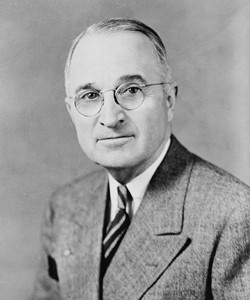
Thirty-third President of the United States (Democrat)
In Office April 12, 1945 – January 20, 1953
Harry S. Truman (b. 1884 – d. 1972)
Known chess player.
Learned chess from his uncle and namesake, Harrison Young. In Harry S. Truman: A Life, author Robert Ferrell writes, “Harry loved to play games with his uncle, who was a genius at checkers, chess, and poker…” Truman also mentions his uncle’s skill at the game in The Autobiography of Harry S. Truman.
On March 3, 1947, Truman, in a speech in Mexico City addressing Mexican President Miguel Aleman stated: “International relations have traditionally been compared to a chess game in which each nation tries to outwit and checkmate the other. I cannot accept that comparison with respect to the relations between your country and mine, Mr. President. The United States and Mexico are working together for the mutual benefit of their peoples and the peace of the world. You have made me feel, what I could not have doubted in any case, that I stand here, in the midst of the great people of Mexico, as a trusted friend and a welcome guest.”
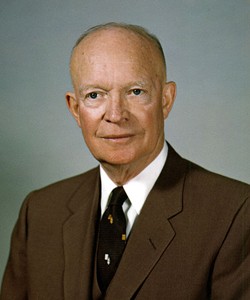
Thirty-fourth President of the United States (Republican)
In Office January 20, 1953 – January 20, 1961
Dwight D. Eisenhower (b. 1890 – d. 1969)
Did not play chess.
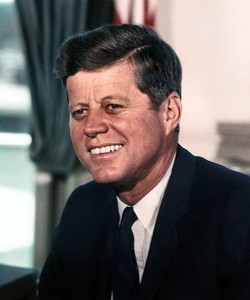
Thirty-fifth President of the United States (Democrat)
In Office January 20, 1961 – November 22, 1963
John F. Kennedy (b. 1917 – d. 1963)
Known chess player.
In 1962, he received a chess set as a birthday gift from a close friend and major supporter. The set is made of rare wood and the board is made of hand-cut squares of black and brown crocodile hide. The pieces are ebony and ivory. A letter from Evelyn Lincoln, the Personal Secretary to the President, was sent after Kennedy’s assassination thanking the giver of the set and telling him that President Kennedy would want him to have the set back as both he and the President were avid chess players. The chess set ended up in the estate of “Rat Pack” member Peter Lawford who was married to Patricia Kennedy, JFK’s sister. Lawford was also a close, personal friend of JFK.
According to Josef Vatnikov’s book, Essay on Chess, John F. Kennedy Jr. was a very good chess player. He writes about a trip that members of the Kennedy family took to Russia in 1975:
In 1975, the Kennedys visited Moscow University where they acquainted themselves with its chess club. Sargent Shriver, a well-known American political figure, was at the head of the family delegation. His wife, the older Kennedy’s sister, their children and relatives became members of this group. It was very interesting to all of them. John Kennedy Jr., the President’s son, was at the center of attention. While foreign guests looked over many chess photos on display, and heard my explanations, two Americans stepped aside and sat down at the chessboard. The young John Kennedy Jr. and his cousin Mark, Shriver’s son, were engaged in a passionate chess battle. Many spectators watched their moves. “John is very capable in chess,” students whispered to each other. Some university grandmasters suggested that if the younger Kennedy would attend classes as a foreign student at Moscow State University, they would help him to achieve a high chess level.
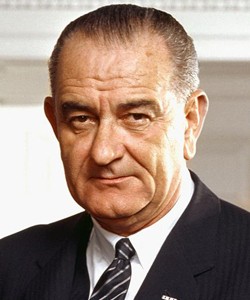
Thirty-sixth President of the United States (Democrat)
In Office November 22, 1963 – January 20, 1969
Lyndon B. Johnson (b. 1908 – d. 1973)
Did not play chess.
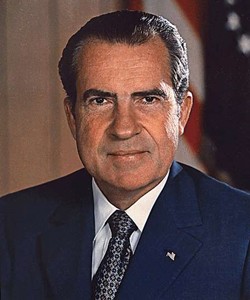
Thirty-seventh President of the United States (Republican)
In Office January 20, 1969 – August 9, 1974
Richard Nixon (b. 1913 – d. 1994)
Did not play chess.
Though Nixon did not play chess he became very interested in Bobby Fischer and his defeat of the Russians in the World Chess Championship in 1972. This was an important event and had many implications in the Cold War.
Nixon sent a letter to Bobby Fischer congratulating him on his success at the 1970 Interzonal. “I wanted to add my personal congratulations to the many you have already received. Your string of nineteen consecutive victories in world-class competition is unprecedented, and you have every reason to take great satisfaction in your superb achievement. As you prepare to meet the winner of the Petrosian-Korchnoi matches, you may be certain that your fellow citizens will be cheering you on. Good luck!”
Nixon sent a letter to Bobby Fischer congratulating his victory over Tigran Petrosian in Buenos Aires in 1971, the qualifying match leading up to the World Chess Championship. Nixon wrote, “Your victory at Buenos Aires brings you one step closer to that world title you so richly deserve, and I want you to know that together with thousands of chess players across America, I will be rooting for you when you meet Boris Spassky next year.”
Nixon sent Bobby Fischer a telegram of congratulations after he defeated Boris Spassky in the 1972 World Chess Championship.
Nixon invited Fischer to the White House after his World Chess Championship win in 1972. It was heavily debated whether or not this should occur because of Fischer’s unpredictable and troublesome nature. However, prior to Fischer’s death he exclaimed, “I was never invited to the White House. They invited that Olympic Russian gymnast—the little communist Olga Korbut.” In his book, Bobby Fischer, photographer Harry Benson claims, “Both Nixon and Kissinger asked me to extend an invitation to Fischer to visit the president in Washington when the match concluded. I told Bobby…and he mumbled something about being ‘too busy’ to bother with that now.”
Nixon’s Secretary of State, Henry Kissinger, played chess. Kissinger called Bobby Fischer to encourage Fischer to play Spassky in 1972 when Fischer was refusing to go to Iceland for the match.
Nixon presented a chess set created by American master woodworker Robert Whitley to the USSR. It is in the collection of The State Hermitage Museum in St. Petersburg, Russia.
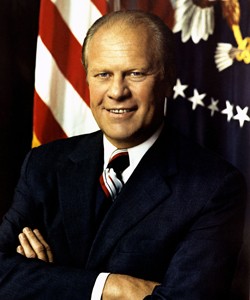
Thirty-eighth President of the United States (Republican)
In Office August 9, 1974 – January 20, 1977
Gerald Ford (b. 1913 – d. 2006)
Did not play chess
President Ford declared October 9, 1976 National Chess Day. In his letter declaring this, he wrote:
I welcome this opportunity to greet America’s chess players and to give special recognition to a game that generates challenge, intellectual stimulation and enjoyment for citizens of all ages. This national observance focuses on the champions who have mastered the intricate skills of this exciting game as well as the countless fans who find it a constructive way to spend their leisure hours. For both professional and amateurs, chess is a game that sharpens the mind, tests human faculties and encourages healthy competition. It has captivated the attention of players and spectators worldwide and will continue to do so as long as competition and excellence challenge mankind.
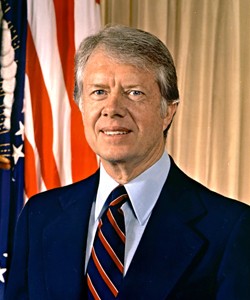
Thirty-ninth President of the United States (Democrat)
In Office January 20, 1977 – January 20, 1981
James (Jimmy) Carter (b. 1924)
Known chess player.
According to the Christian Science Monitor from December 12, 1988, he wanted to become a chess expert after he left the White House. He bought several chess books and a computer chess program but he had difficulty mastering the game. Carter stated, “I found that I don’t have any particular talent for chess. I hate to admit it, but that’s a fact.”
Carter’s National Security Advisor, Zbigniew Brzezinski, was an avid chess player who played Menachem Begin, Prime Minister of the State of Israel, at Camp David Accords in 1978.
In 1993, Carter hand-carved a chess set and auctioned it for charity through the Carter Center. Saudi Arabia’s Prince Bandar bin Sultan paid $102,300 ($92,000, plus the buyer’s premium) for the set.
In his book, Virtues of Aging, Carter wrote, “Like golf or chess, fly fishing offers a never-ending challenge to improve skills, practice, and knowledge.”
In 1977, Jack Carter, Jimmy & Rosalynn’s oldest son, wrote a letter to the U.S. Chess Federation. Jack was answering a letter sent by USCF Life Member Irwin W. Fisk who had asked the 1976 Presidential and Vice Presidential candidates if they played chess. Jack Carter wrote, “Mr. Fisk, I am Jack Carter, Jimmy’s oldest son. My father at one time played chess and in fact taught me to play some 20 years ago. I presumed he played some in the Navy and not much after he got back to Plains in 1953. His interest sparked mine and many years later I played tournament chess at about a 1600 level. He hasn’t played with me since he thought he might lose. Sorry about the delay but we are busy. Jack Carter.”
In 2005, Carter was invited to participate in the Chess for Peace event with President Mikhail Gorbachev and former World Chess Champion, Anatoly Karpov, but had a busy schedule and could not participate. He wrote the following letter to a FIDE (World Chess Organization) Organizer, dated September 6, 2005:
To Dr. Mikhail Korenman, Thank you for your invitation to participate in the Chess for Peace event at the Anatoly Karpov International School of Chess in Lindsborg, Kansas. I appreciate the opportunity to share in this important project with President Gorbachev. Unfortunately, previous commitments with The Carter Center make it impossible for me to be with you on October 29, 2005. I am grateful for your hard work to promote peace. Please accept my best wishes for a successful event. Sincerely, Jimmy Carter.
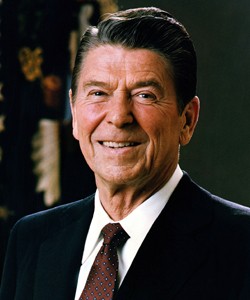
Fortieth President of the United States (Republican)
In Office January 20, 1981 – January 20, 1989
Ronald Reagan (b. 1911 – d. 2004)
Did not play chess.
Reagan sent a letter of congratulations to Victor Palciauskas of the United States, who won the 10th World Correspondence Chess Championship in 1984.
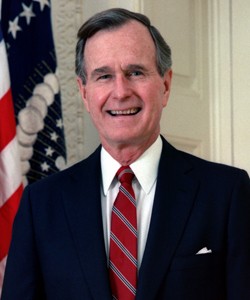
Forty-first President of the United States (Republican)
In Office January 20, 1989 – January 20, 1993
George H.W. Bush (b. 1924)
Does not play chess.
In 1989, President Bush and
his wife, Barbara, visited Budapest and were introduced to the Polgar sisters, Susan, Sofia, and Judit.
President Bush received a Desert Storm chess set as a gift. As of 2003, it is stored in the National Archives: “Howard Kellogg of Fuquay-Varina, N.C., was so impressed with the way President Bush and Gen. Norman H. Schwarzkopf handled the crisis in the Persian Gulf that he spent months building chess sets for both of them in a Desert Storm motif. The board is blond rock maple, suggesting desert sand, the squares lined in black, for oil. The game pieces warplanes, helicopters, tanks and missile launchers made of lead sit atop oil drums. The Iraqi “king” is a mustachioed soldier representing Saddam Hussein. He opposes a bare-chested shotgun-toting “Rambo” figure in striped Uncle Sam pants.”
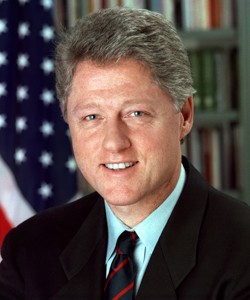
Forty-second President of the United States (Democrat)
In Office January 20, 1993 – January 20, 2001
William (Bill) Clinton (b. 1946)
Known chess player.
In 1968, Bill Clinton won a Rhodes scholarship to study at Oxford. While he was at Oxford he played chess with some of the other students. Steve Mooring was a friend of Clinton while at Oxford. They played chess regularly, but Steve said that Clinton was a poor chess player, with an estimated playing strength of 60 (British rating), or under 1100 in USCF rating.
Clinton is a big supporter of the Chess-in-the-Schools program and has met with Garry Kasparov. In 2007 he wrote Giving: How Each of Us Can Change the World and mentions the Chess-in-the-Schools program and how it was a classic example of a very good idea with no chance of becoming a reality without private support. Clinton pointed out that playing chess helps students develop thinking an analyzing skills, concentration, greater self-control, and self-confidence.
One of Clinton’s favorite desserts is Lemon Chess Pie. In fact, if you do an internet search for the recipe, it is actually called Bill Clinton’s Lemon Chess Pie.
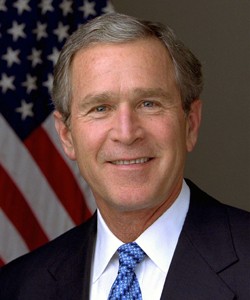
Forty-third President of the United States (Republican)
In Office January 20, 2001 – January 20, 2009
George W. Bush (b. 1946)
Does not play chess.
In 2004, Boris Spassky wrote a letter to President Bush appealing to let Bobby Fischer go free and not be subject for arrest because he played chess in Yugoslavia. Spassky received no sanctions from the French government. From ChessBase Magazine, August 10, 2004.
President Bush posed for pictures with former World Chess Champion Garry Kasparov on September 23, 2008 in New York. One picture shows Bush holding Kasparov’s book, How Life Imitates Chess.
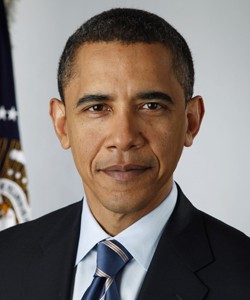
Forty-fourth President of the United States (Democrat)
In Office January 20, 2009 – January 20, 2017
Barack Obama (b. 1961)
Known chess player.
First Lady Michelle Obama also plays chess. A February 14, 2008 New York Times article stated that “Mrs. Obama and her brother were expected to fill their time with books, chess, sports—and, critically important they both said, dinnertime conversations with their parents.”
In 2009, President Obama spoke at the New Economic School, a graduate economic school in Moscow and used chess as a metaphor. According to The Independent on July 8, 2009:
Barack Obama pulled his punches in Moscow yesterday, preaching democracy and democratic values but carefully refraining from direct criticism of Russia and its leaders. In a carefully calibrated speech to graduating students of a liberal economic institute, he continued his policy of “pressing the reset button” with Russia, steering clear from harsh rhetoric about its democratic and human rights credentials. Reading between the lines, however, there was plenty of veiled criticism. “In 2009, a great power does not show strength by dominating or demonising other countries,” Mr. Obama told a packed hall of students and lecturers from the New Economic School in central Moscow. “The days when empires could treat sovereign states as pieces on a chess board are over.”
President Obama also met with former World Chess Champion Garry Kasparov on his 2009 trip to Russia.
In 2009, Henry Kissinger (a chess player) was interviewed by Spiegel Online. He said that “Obama is like a chess player who is playing simultaneous chess and has opened his game with an unusual opening. Now he’s got to play his hand as he plays his various counterparts. We haven’t gotten beyond the opening game move yet. I have no quarrel with the opening move.”
In Afghanistan, Allied troops have been playing Osama vs. Obama “terror chess.” The traditional pieces have been replaced with late terrorist Osama Bin Laden and U.S. President Obama as respective kings. The rooks have been replaced by the World Trade Center towers. The Statue of Liberty is the queen. A map of Afghanistan is superimposed over the classic checkerboard pattern. The controversial board game has been produced by Hobby Leisure Manufacturing and is the brainchild of CEO and ex-Canadian Special Forces soldier Jeffery Train from Toronto, according to The Hindustan Times from July 23, 2011.
Both the President and First Lady met with and had a private dinner with World Chess Champion Viswanathan Anand in 2010.












































